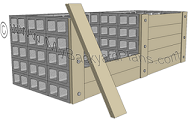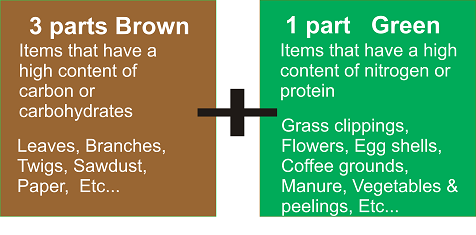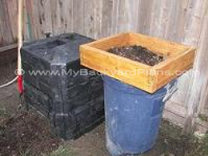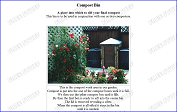How to Compost - Easy To
Follow Instruction
Good compost is of great value in gardening, whether you use organic
gardening methods or not. But buying compost can be expensive, especially
if you’re gardening a fairly large plot of ground. And when
something becomes expensive, we’re less likely to use as much
of it as we might otherwise, and that’s not good. Compost is
of such importance in successful gardening that it’s best not
to restrict its use if possible. To avoid this dilemma, why not learn
how to compost? It’s easy to do, and making your own compost
provides benefits beyond simply saving money.
What to Compost
Compost is simply organic matter that has been broken down by microbial
activity. Compost can be made with virtually any organic material
(though there’s a few ingredients listed below that you shouldn’t
use), but when starting a compost pile, the ingredients will fall
into one of two categories:
1.Browns – Leaves
that you’ve raked, branches and twigs, and sawdust are examples
of Brown ingredients, but an item does NOT have to be brown to be
a Brown ingredient.
Tree leaves, for example, are Brown ingredients whether they’re
dead on the ground or fresh from the tree. Brown ingredients are items
that have a high content of carbon or carbohydrates. If you’re
not sure if an item falls in this category, wet it, wait for a few
days to let it start decomposing, and then smell it. If it does not
smell bad, then it belongs in the brown category. If it stinks, then
it belongs in the next category.
2.Greens – Grass
clippings from your lawn, vegetable or fruit scraps from the kitchen,
and even coffee grounds are Green ingredients. Green ingredients are
items that have a high content of nitrogen or protein. You can use
the smell test described above to tell if an item falls in this category.
If it stinks, it’s Green.
Things NOT to Put in Your Compost
Pile
You can turn most of your garbage into gold by composting it, but
there are a few things NOT to put in your compost pile. According
to the Environmental Protection Agency, it would be best to leave
these things out:
Black walnut tree leaves and twigs
Coal or charcoal ash
Dairy products
Plants that are known to be diseased or hosting insect pests
Fats, grease, lard, oils
Meat or fish bones and scraps
Pet waste, including used cat litter
Yard trimmings known to contain chemical pesticides
How to Compost
A
compost bin is not required. But, it will keep the pile organized,
and will also make it easier to turn. Free
Compost Bin Plans. 
If you have any particularly large pieces, it’s best to first
chop or shred them into smaller pieces. If you’re using tree
trimmings, for example, don’t just throw a branch in the Brown
pile; run
it through a shredder first, or at least chop it into smaller
pieces. Make certain that all of the ingredients are well moistened.
Once you’ve gathered and prepared your ingredients, it’s
time to make the compost pile. As you build the pile, the goal is
to have a ratio of 3 parts Brown ingredients to 1 part Green ingredients.
One way to do this is to alternate layers of Green and Brown ingredients,
with the Brown layers 3 times thicker than the Green. Once all your
ingredients are in the pile (or the pile is as large as you want it),
thoroughly mix all the ingredients together. If you can, cover the
pile with a tarp to keep it from getting too dry and to prevent rainfall
from leaching out some of the nutrients.
Though not necessary, turning the pile frequently will help to speed
the composting process. Turning it every few days will keep the composting
process working at maximum speed, but turning it much less frequently
will still help. Composting should be an aerobic process, and turning
helps to keep the pile aerated throughout. If you detect any foul
odors emanating from the pile, this is an indication that some parts
of the pile aren’t getting oxygen, and so the pile needs to
be turned or mixed. After a period of weeks to months, depending upon
the ingredients and the amount of turning, your compost will be a
rich brown, crumbly mix, ready to use.
So now, kitchen scraps that you used to throw in the garbage and the
lawn clippings that used to go to the landfill will serve a valuable
purpose. And there’s no longer any reason to feel guilty about
wasting food. With a compost pile to feed, there’s almost no
such thing as waste!
|





